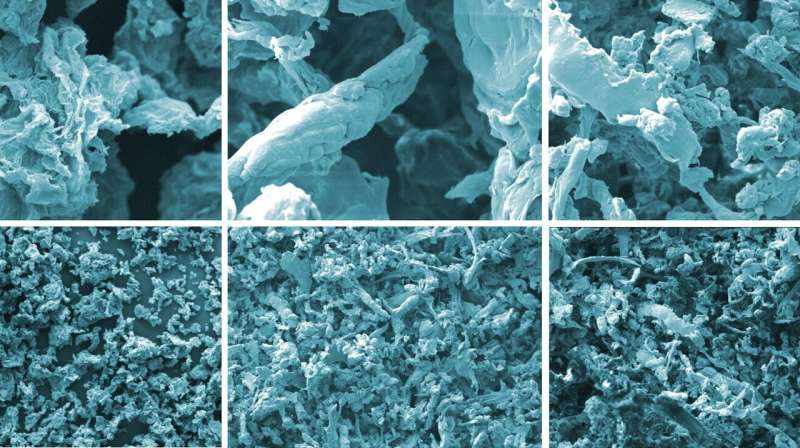
Graphene-related materials (GRMs) are often used to reinforce polymers. In small concentrations of up to five weight percent, GRMs can significantly enhance the strength, electrical conductivity and thermal transport of composites for a variety of applications. However, being a relatively new set of materials, graphene and GRMs need to be carefully assessed in order to identify potential adverse effects prior commercialization.
In a new study, a large interdisciplinary team of scientists funded by the EU’s Graphene Flagship project prepared a composite of polyamide 6 (PA6, also known as Nylon-6)—a thermoplastic polymer used in several sectors such as automotive and sports equipment—with 2.5% reduced graphene oxide (rGO), a form of graphene that enhances the reinforcement of the polymer. Then they abraded this material mimicking further processing or end-of-life scenarios, creating particles with an average diameter of 1.9 μm for rGO-PA6 or 3.2 μm with pure PA6, respectively.
Airborne materials
The researchers analyzed and compared the effects of the abraded particles consisting of either PA6-rGO, PA6 alone or pure rGO along the most likely exposure routes. Therefore, they used cell-based models representing human lungs, the gastrointestinal tract, the skin and the immune system as well as an in vivo mouse model for pulmonary exposure.
The researcher found only limited acute responses after exposure to PA6-rGO in the different cell-based models. Only rGO induced substantial adverse effects, in particular in macrophages, a type of immune cells. Since inhalation of airborne materials is a key occupational concern, the team conducted a single exposure study in mice. In agreement with the acute in vitro data, PA6-rGO induced a modest and transient pulmonary inflammation. Overall this comprehensive study suggests a likely low risk to human health at acute exposure conditions of rGO-PA6. However, further studies would be required to assess chronic effects or impact on patients suffering from chronic obstructive pulmonary disease (COPD) or asthma.

“We aim to anticipate the ‘what if?’ scenario prior to the broad use of these emerging materials to avoid future social and economic drawbacks,” says Empa scientist Peter Wick, the lead author of the study. “We anticipated questions, which will become relevant for the ‘Chemicals Strategy for sustainability towards a toxic-free environment’ of the European Commission, facilitating the safe and sustainable use of GRM-reinforced materials. This was only possible thanks to a multidisciplinary team of experts in polymers, graphene and nanosafety, favored by the Graphene Flagship ecosystem.”
Andrea C. Ferrari, Science and Technology Officer of the Graphene Flagship and Chair of its Management Panel, adds: “This comprehensive study of possible toxicity of graphene-polymer composite fragments highlights the central role that health and safety plays in the Graphene Flagship since its very beginning. When these composites are processed into industrial parts, one needs to seriously consider the possible health implications due to emitted/abraded particles. It is reassuring to see this study shows negligible effects, thus confirming the viability of graphene for mass applications.”
More information:
Savvina Chortarea et al, Hazard assessment of abraded thermoplastic composites reinforced with reduced graphene oxide, Journal of Hazardous Materials (2022). DOI: 10.1016/j.jhazmat.2022.129053
Provided by
Swiss Federal Laboratories for Materials Science and Technology

READ MORE
Scientists pit AI algorithms against each other to optimize graphene nanotube synthesis
AI combat: Artificial neural networks proved better than other models for optimizing the synthesis of [...]
Carl Warner’s Mountains Are Made of Elbows and Knees
Valley of the Reclining Woman Carl Warner Two and a half years ago, Carl Warner [...]
Lizards With Bigger Toes and Smaller Hind Legs Survive Hurricanes
Anolis scriptus, the Turks and Caicos anole, on Pine Cay Colin Donihue It was August [...]
Why is there air in my brake lines?
Brake fluid absorbs moisture. That’s easy enough to understand, right? But how does moisture in [...]
What Does E.O. Wilson Mean By a “Social Conquest of the Earth”
Pulitzer Prize-winning scientist E.O. Wilson appears in his office at Harvard University, in Cambridge, Mass. [...]
Anchoring single atoms for catalysis
The atomic model shows a single indium atom (blue), which is anchored by a silicon [...]
Ask Smithsonian: What Is a Dimple?
What gives Brad Pitt that special twinkle? And what is it that makes Jennifer Garner [...]
What to Take to an Interview
What do you take into the interview? It’s really tempting to take everything into the [...]